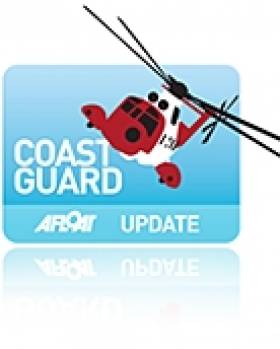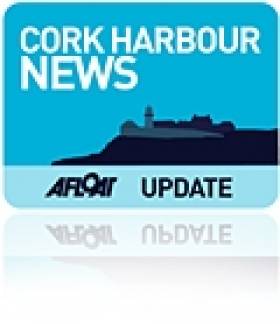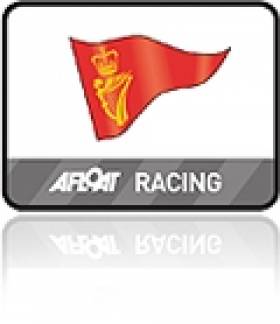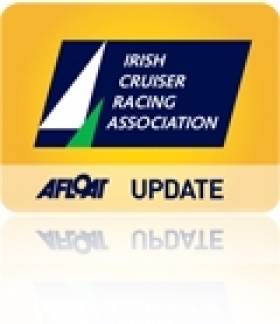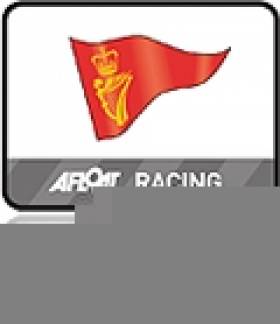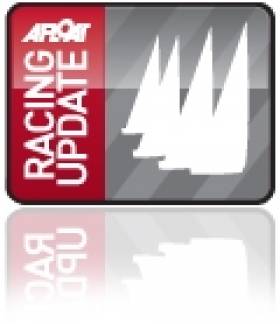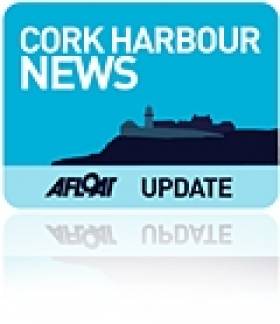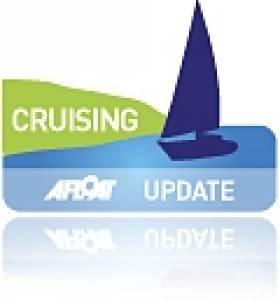Displaying items by tag: Crosshaven
Cork Week Changes Dates for 2012
Next year's Cork Week regatta at Royal Cork Yacht Club, one of Ireland's biggest sailing events, has changed dates from 30th June – Friday 6th July to 7th-13th July 2012 following consultation with both local and overseas participants.
The decision was made to change the date of the biennial event because it would have otherwise have clashed with Britain's Round the Island Race on June 30th.
'Following continuing contact with the OPW, it has been confirmed to me that a new contract for the construction of the new station has been awarded and work is to start very soon. This tender process has been ongoing for more than a year and I am delighted that it has finally been awarded and work to commence shortly.'
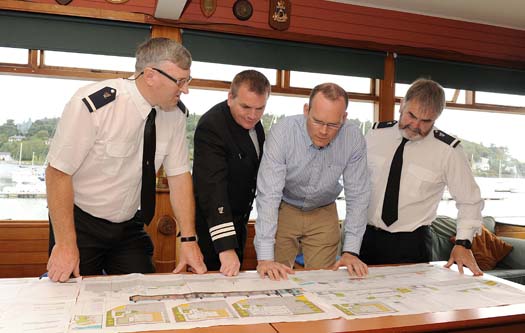
Marine Minister Simon Coveney TD with Victor Shine Deputy Area Officer Crosshaven Coast Guard Unit, Vincent Farr Area Officer and James Furlong Unit Member looking over the plans for the new €1.5 Million Coast Guard Station at Crosshaven, Co. Cork. The contract has been awarded to Blarney firm Cumnor Constuction Ltd and work will commence shortly. Photos Billy macGill
'Those who work at Crosshaven Coast Guard are to be commended for their commitment and dedication to the local community in a voluntary capacity. We must now ensure that they are working in a station that reflect this loyalty and high standard of service.'
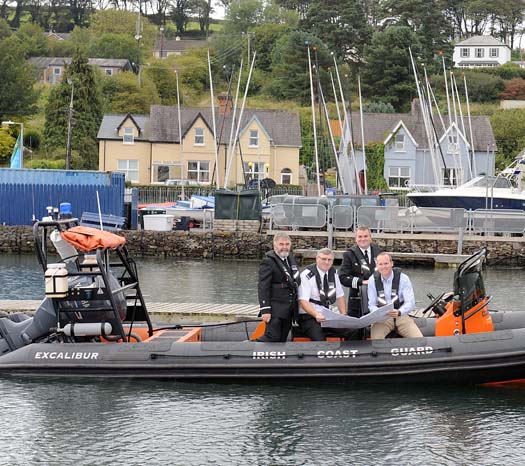
The contract has been awarded to Cumnor Construction Ltd. of Blarney on August 3rd. Work on the site is expected to commence very shortly.
‘Call for Events’- Cork Harbour Open Day
This year's Cork Harbour Open Day will take place on Saturday 10th September. The event aims to embrace the best of what Cork Harbour has to offer.
The Open Day seeks to raise awareness of the different free activities and events available for families in the harbour both on and off the water. If you would like to be involved in Cork Harbour Open Day or organise an event on the day, please contact Sara MacKeown Tel: (021) 4625375 or by email: [email protected]
All of the events will be promoted on the lead up to the day via PR, advertising and social media. For further information www.corkharbour.ie
Cork Harbour 'Mid-Summer Madness' Attracts 40 Boats
Adrielle was on station in her refurbished state with the crew still putting finishing touches to the portholes and mighty fine she looked too. Martin Almond and the Race Team sent the cruisers on course 93, two rounds for Class One and one for the other classes plus a course for the Whitesail fleet that included a beat out to number 6. As that fleet came around number 6 they were met by the other fleets coming in the harbour and it was nearly as busy as Piccadilly Circus. Nobody minded as they had a lovely 6 to 8 kts southerly breeze to make for very enjoyable sailing and made the most of the evening.
Aprés sailing there was a rush to get back to the club, for once not to have to get in out of the weather but this time the rush was to grab a seat and enjoy their barbeque food in the outside Patio dining area. I hasten to add the club was also jammed to the hilt as the sailors awaited the call to announce results and prize giving. While waiting the sound of great live music floated over Crosshaven and it was just one tremendous summer evening of sailing and fun.
At last the moment arrived and Vice Admiral Peter Deasy sounded the call to arms and Rear Admiral Ronan Enright warned anyone not present outside for the prize giving would not be considered for the draw for the Marine Motors engine which prompted a dash to the patio area. After the Leagues prize giving three tickets were drawn. Tim O'Mahony from the O'Shea/Durcan T Bone, Michael Wallace of Felix and Derry Nash of Catalpa were the tree names. Two of the three would get bottles of champagne with the last remaining name getting the engine. Derry Nash turned out to be the lucky punter and was thrilled with his luck on the night.
Next Thursday night a new sponsor, the very well known Timberland, will be on board for the July league. Racing will take place on July 7th, 14th, 21st and 28th. The company is offering a 20% discount on their products for RCYC members on production of their membership cards.
ICRA Racing Underway in Crosshaven
The conditions were ideal with a 7–knot breeze coming from the S.E. with flat water, blue skies and at the top of the tide. The harbour was looking its best.
The Race Officer set an excellent course. A bit of bias on the line made the start a bit interesting though. Class One got away clean. But Classes two and three had a General Recall.
After the start at Grassy the fleet had a beat out to No.3 The usual debate ensued over which side of the course was favoured. It was a close call in the end. Around No. 3 to starboard, spinnaker up and back to the Cage Bouy. A gybe and then on to No.12 at this stage there was a nice bit of ebb in the tide. It really was a case off keeping the Spinny flying for as long as possible up to the Mark. A nice beat followed, down to Corkbeg and then a nice reach back to the Grassy where the S flag was flying.
It was a good night for Billy Duane in his Sunlight 30 Expression in the White Sail fleet and for Jimmy Nyhan and Maritta Buwalda in their 1/4 Tonner Outrigger in Class 3.
First places also went to Thunderbird a Corby 25 owned by Denis Coleman in Class 2 and Endgame an A35 owned by Frank Doyle in Class 1.
Regatta Entry Deadlines Looming
Deadlines for entry in to a number of this season's key sailing regattas are looming. Volvo Dun Laoghaire Regatta's significantly reduced early bird entry rate for the July 7th event will end on Monday and offshore racers intending to race in June 11th's 320-mile Dun Laoghaire to Dingle Race must enter by next Friday 20th. The ICRA Cruiser Championships in Crosshaven takes place from the 17th to 19th June, a fixture that suits those boats intending to compete in the Dingle race. Race details can be downloaded below.
1720 European Championships to be Launched on the Lee
The 1720 Sportsboat European Championships and the class national championships will be launched at a "Sailing By The Lee" event on Friday 29th April, 2011 where six 1720's will be raced on the River Lee adjacent to the Headquarters of the Port of Cork. The boats will be brought up river on the Thursday evening and racing will commence at lunch time on the Friday (see below for the Eddie English weather video) which say the class will provide photo and media opportunities at the new marina in the Port of Cork. Each boat will carry sponsorship flags.
In June up to 20 boats go back to their roots when the fleet gathers at Royal Cork Yacht Club for the CH Marine Sponsored National Championships.
A fleet of between 30-35 boats will contest the Corona sponsored Europeans when they set sail off Baltimore in September. There are already confirmed entries travelling from Scotland, Isle of Man, England and Wales while there is also interest coming from Holland where a fleet of eight boats is currently active.
The robust Irish 1720 design has been celebrating a comeback in recent years after cheating death by atrracting a strong following in West Cork, spearheaded by some of the rebel county's top sailors.
The fleet is rapidly becoming the most popular one design keel boat in this part of Ireland. There are now established and growing fleets at Royal Cork, Crosshaven, Kinsale, Baltimore and Schull while Galway Bay also has a growing fleet, racing in Galway Bay. The 2010 Nationals attracted a fleet of over twenty boats,
The series itself will be sailed over a three day period starting on Thursday, 1st September and consisting of nine races in total, three per day. Notice of Race and Entry Forms will be available shortly from Baltimore Sailing Club.
Tributes Paid to Cork Boat Builder George Bushe
Sailing tributes have been paid to legendary boat builder George Bushe, who died last week aged 89.
Born in Baltimore, Co Cork, Bushe got his start in boat building through his father, who make traditional punts. From there he went on to Skinner's Boatyard in Skibbereen and worked with the late Jack O'Driscoll in Ringaskiddy.
In the 1960s and '70s he worked at the Southcoast Boatyard in Rochestown, where be built many famous racing boats for Cork's premier sailing clans - such as the Golden Apple for the late Hugh Coveney, father of Minister for the Marine Simon Coveney.
Bushe went into semi-retirement in the 1970s, working at the Royal Cork Yacht Club, restoring boats in winter and even racing his own until the mid 2000s.
His remains were carried to St Patrick's Cemetary in Crosshaven aboard the Cánóg, the last boat he completed and which he raced competitively as recently as 2006.
George Bushe is survived by his wife Carmel and their children: Bernice, Fergus, sail maker Majella, shipwright Mark, and boat builder and sailor Killian Bushe, who just last month received the Fastnet Award for his own contributions to sailing.
The Irish Examiner has more on the story HERE.
Irish Cruising Club Present Fastnet Award to Killian Bushe
So whenever a high-powered strongly-resourced international challenge is taking shape, Bushe is the boat-builder of choice, favoured by leading designers and top skippers alike. But if you have a challenge in mind and he is top of the list, please join the queue.
For at the moment, he is immersed as leading consultant in building the new Groupama 4, the top French Volvo 70 for Franck Cammas. Before that, he built the two successful Ericsson boats for the last Volvo – they took first and fourth. In fact, he has built the overall winners of the last three Volvo races. And when Groupama 4 is launched in May and signed off for the race (which starts on October 29th) Bushe returns his focus to Sweden which is now his home, where he has been involved with the Artemis challenger for the America's Cup 2013.
For that project, the designer is Juan Kouyoumdjian, and the skipper is Paul Cayard. This is stratospheric stuff, but that's the level where Bushe operates. With more than thirty years of high tech boat building experience, and a string of success that is mind-boggling, he is the gold standard. But beyond that, he is still the Crosshaven kid who started his racing on his father George's Avocet (which George designed and built), and internationally he is the spirit of Cork sailing.
His renowned skill and knowledge in the use of advanced materials and composites is such that you'd expect him to be awarded a Honorary Doctorate in chemistry from some appropriate university. But in the meantime, his special place in Irish and world sailing was honoured on Saturday March 26th with his award of the Fastnet Trophy.
This trophy is co-ordinated by the Irish Cruising Club, and it operates in very broad brief. Initiated in 2005 with its first award to Paddy Barry and Jarlath Cunnane for their pioneering circuit of the Arctic via both the Northwest Passage and the Northeast Passage, its unique lineage has been maintained by such awardees as Robin Knox-Johnston, and the most recent one, centenarian circumnavigator Bill King of Galway.
The Fastnet Trophy is envisaged as highlighting a contribution to sailing which has a sense of the unique about it, and Killian Bushe is just the man. His international sailing achievements began back in 1976 when he was one of the crew that won the Half Ton Cup at Trieste in the Cork-built Silver Shamrock. They celebrated by sailing up the Grand Canal in Venice with spinnaker set. But gradually the boat-building took over, though Bushe sails with his family in Sweden whenever he can. That is what was being celebrated on Saturday night. Killian Bushe – very good sailor, extremely good boatbuilder.



























